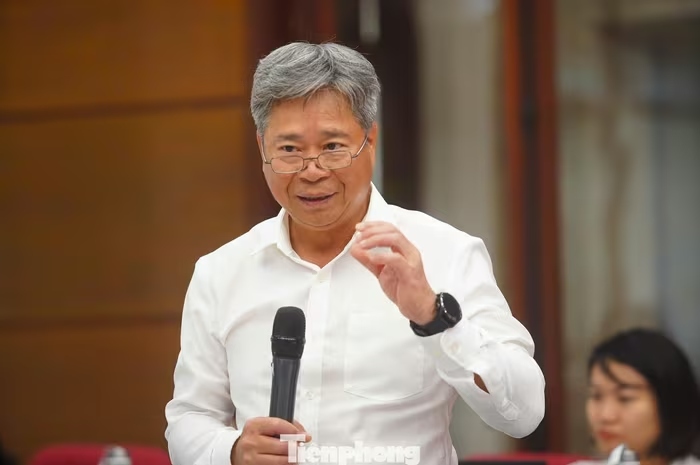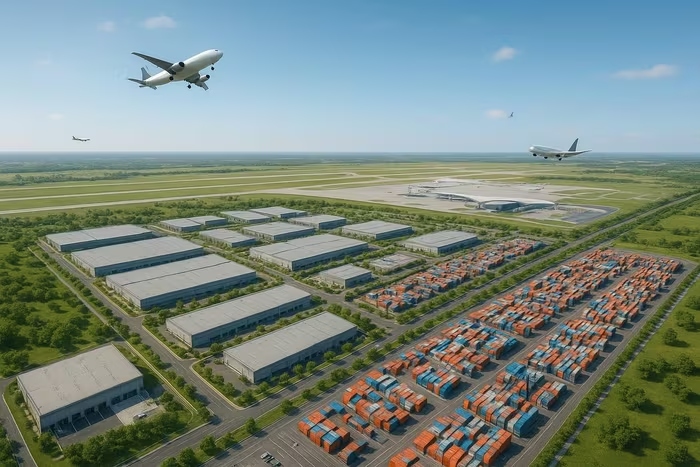Regional Aviation Hub
Speaking at the seminar “Businesses in the Digital Era: Creating Imprints and Integrating Globally,” Mr. Pham Quang Hieu – Deputy Head of the Department of Technology and Environment, Airports Corporation of Vietnam (ACV) – stated that Long Thanh International Airport is the largest investment project in the history of Vietnam’s aviation industry, and ACV is accelerating its completion progress.
With its scale, technology, and strategic vision, Long Thanh is not only a key national infrastructure project but also a symbol of Vietnam’s ambition to become a new aviation transit hub in Southeast Asia.

Mr. Pham Quang Hieu – Deputy Head of Technology and Environment Department, Airports Corporation of Vietnam.
According to Mr. Hieu, aviation has long been regarded as the “lifeblood” connecting the world, helping to boost trade, tourism, investment, and integration. Each 1% growth in aviation can drive a 0.5–1% increase in GDP, particularly in logistics, commerce, and services. In that context, Long Thanh is expected to become a new “growth engine” for Vietnam’s economy — easing the load on Tan Son Nhat Airport while expanding the nation’s international connectivity.
Once the first phase is completed, Long Thanh Airport will serve 25 million passengers and 1.2 million tons of cargo annually. At full capacity, it is expected to handle 100 million passengers and 5 million tons of cargo per year — comparable to major regional “mega-airports.”
Located about 40 km from Ho Chi Minh City, Long Thanh sits within Vietnam’s largest logistics triangle, offering convenient connectivity via highways, railways, and, in the future, an inter-regional metro system.
According to ACV, the airport completed its technical calibration flight on September 26 and is expected to be officially handed over and put into operation on December 19, 2025.

Long Thanh Airport completed its technical calibration flight on September 26 and is expected to be handed over on December 19, 2025. Photo: ACV.
Toward a “Smart Airport” Model in the Region
Mr. Hieu noted that to operate a project of national significance, ACV is implementing three strategic pillars: technological infrastructure, commercial operation, and human resource management.
In terms of technology and design, Long Thanh is envisioned as a “green and smart airport”, integrating cutting-edge technologies in air traffic management, process automation, and energy efficiency. Environmentally friendly design solutions will help reduce carbon emissions, optimize operating costs, and provide flexibility for future expansion.
On the commercial side, ACV aims to attract major international airlines such as Singapore Airlines, Cathay Pacific, and Emirates, forming a regional transit network. Commercial zones, hotels, conference centers, and logistics services will be developed in parallel, transforming Long Thanh into a modern “aerotropolis” — a dynamic hub for logistics, tourism, and global trade.
Additionally, ACV is focusing on developing a professionally trained workforce that meets international standards, following IATA Level 2 operational models. This will not only enhance competitiveness but also position Long Thanh among the leading modern airports in the region.

Long Thanh opens the gateway for Vietnam to rise as a logistics, trade, and tourism hub in Southeast Asia. Illustration: AI.
To become a regional aviation hub, Long Thanh will have to compete directly with major players such as Changi (Singapore), Suvarnabhumi (Thailand), and Kuala Lumpur (Malaysia) — airports that have long established their dominance in regional transit.
According to ACV, the biggest current challenge lies in infrastructure connectivity. Road, rail, metro, and expressway systems linking to the airport must be developed synchronously to prevent Long Thanh from becoming “isolated” from key economic centers.
Major transportation projects such as the Bien Hoa – Vung Tau Expressway, Ho Chi Minh City Ring Road 3, and the Thu Thiem – Long Thanh railway line are being prioritized to ensure the airport’s efficient operation from its very first day.
“Long Thanh is not merely an airport; it is a symbol of national ambition, integration, and digital transformation. The project embodies modern technology, environmental sustainability, and new opportunities for aviation, logistics, tourism, and international investment,” Mr. Hieu emphasized. With a long-term vision, ACV aspires for Long Thanh to become a leading aviation transit hub in Southeast Asia, positioning Vietnam firmly on the global aviation map and realizing the dream of ‘Vietnam – The Destination of the Future’.